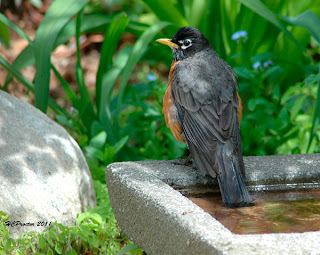Yesterday, we attended a memorial service for a friend who
died suddenly and I was struck by how strongly water figured in the songs,
poems, and images that were used to help us grieve and heal. The most poignant
was of our friend’s relatives in Holland writing her name in the sands of a
beach and watching as the waves washed it away. We don’t have a beach, but our
friend Karin was a great lover of nature and of gardens. So it seems
appropriate to remember her by taking a break from the usual emphasis on detail
and contemplate the broader pattern of how water can contribute to backyard
biodiversity.

One of the most diversity-enhancing aspects of the Home Bug
Garden is the pond. Urban yards are not water-rich habitats but many insects
and other invertebrates spend part or most of their lives in fresh water. Many
others need an occasional sip to quench their thirst, to help build a nest of
mud or carton, or to keep a nest cool on hot days. Songbirds need insects to
eat, water to drink, and – even on the coldest days – seem to relish a bath.
Our pond is small (1x2 m), and not very deep (~0.5 m), but
it is a permanent feature and has the bubbler burbling from May into October.
The pump and filter keep the water relatively clean, the bubbler aerates and,
while not completely masking the city noise, does provide some amelioration.
The bubbler also provides a convenient drinking fountain/bath for those so
inclined.
We enhanced the appeal of the pond area to birds with the
addition of a low, Japanese-style water basin along side. During wet periods,
puddles in the back lane provide an alternative, but a permanent bath makes for
regular visitors from the vertebrate world. If you let cats wander your garden,
then a low water basin is not a good idea, but we don’t and a tall fence and
consistent response to trespassers makes for a safe avian retreat.
The umbrella of the golden willow and surrounding shrubs, and
the shelter of bog plants and emergent vegetation (mostly sedges and rushes) make
the backyard pond a pleasant way stop for migrating songbirds and a regular
hangout for the locals. Without the woody vegetation for cover, perching, and
drying out, we would see far fewer birds and we can only wonder at how such a
diversity of migratory species manages to spy out our tiny lot and stop by for
a drink and a bath.

We had several years before the pond was operational and
even longer before the vegetation was high enough to provide sufficient cover for comparison.
Before then our ‘migrants’ were mostly sandhill cranes, geese, and the like flying
high overhead with not even a stray feather making it into the yard. Since then
we have observed a half dozen species of warblers and an equal number of non-resident
sparrow and finch species stopping by for short rests. Swainson’s Thrushes are
now regular spring and fall visitors and unexpected guests keep surprising us –
Western Tanager, Townsend’s Solitaire, Varied Thrush, Western Wood Peewee,
Yellow-breasted Flycatcher, and even a Wilson’s Snipe.

Some of the migrants may linger for a week or more, but
urban yards do not provide adequate habitats for most of these birds to nest
and rear a brood. Still, we have a respectable dozen or so local residents
using the fountain, bath, and pond: American Robins, Chipping Sparrows, and
House Wrens settle in for the summer; Downy Woodpeckers and White-breasted
Nuthatches stop-by irregularly; and chickadees (both Black-capped and Boreal),
Red-breasted Nuthatches, Blue Jays, Magpies, House Finches, and unfortunately,
House Sparrows, are to be found year round.
I don’t suppose our fauna is anything to get a real twitcher
excited, but by providing cover and a consistent supply of water, we have
increased our own enjoyment of our backyard tremendously. Perhaps we also
contribute a small bit towards avian conservation. However, as anyone who has
watched a chickadee, robin or blue jay take a bath would know, we clearly
contribute a great deal to our avifauna’s enjoyment of life.
To Karin, who made the lives of all she met so much more
enjoyable, we close with this quote from a song sung in her remembrance
yesterday:
“I am flying, flying
Like a bird ‘cross
the sky.
I am flying, passing
high clouds,
To be with you, to be
free.”
From “Sailing”, by
Gavin Sutherland











The garden as a green sanctuary.The sound of the water, the wind in the trees, the activity of the birds and bugs--it gives us a small place of refuge within the city.
ReplyDeleteCondolences.